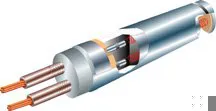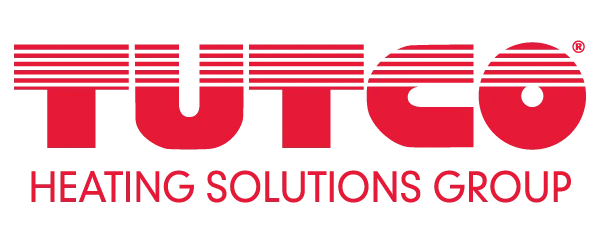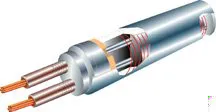Customize Your Cartridge Heater
Customize for a Competitive Edge
Electric heaters come in all shapes and sizes. One of the most popular is the cartridge heater, which can be described generically as a round tube with leads exiting typically at one end that, when attached to an electrical source, produces heat.
Selecting a cartridge heater is no different than selecting other types of heating elements. There are many factors you must consider such as the application, environmental conditions, temperature capabilities and voltage. If this information is not readily available or not known, consider contacting a local distributor in your area that specializes in heating applications for their input. The most common types of cartridge heaters are standard loose pack and standard swaged construction.

Figure 1. In a standard loose pack cartridge heater, ceramic cores provide the electrical insulation for the coiled resistance wire that passes through them.
Standard Loose Pack
The first cartridge heater design was the standard loose pack. Its construction begins with a stainless-steel tube, and extruded ceramic cores with holes running their length are inserted. These ceramic cores provide the electrical insulation for the coiled resistance wire that passes through them, positioning the resistor wire near the center of the heater. Once the core and wire are inserted, magnesium oxide powder is sifted into the holes to assist in dissipating heat. One end of the heater is closed with a metal-end disk and, depending on design, may or may not be watertight. The other end of the heater where the power leads exit the heater typically is sealed with a ceramic cap. Various lead wire styles and lead wire protection are available (figure 1).
Due to the nature of its construction, the loose pack cartridge heater is limited in its ability to produce heat, or watts per square inch. Depending on the application, 40 W/in2 usually is the maximum for this heater design.
Figure 2. In a high temperature cartridge heater, the core assembly consists of a round, crushable magnesium oxide core with two holes running through its length where resistance wire is precision-wound around the core.
High Temperature, Swaged Construction
As the name describes, high temperature swaged cartridge heaters offer superior heating performance vs. standard loose pack cartridge heaters. Because they are constructed differently, they allow for increased watt densities — up to 100 or 150 W/in2 under certain conditions.
The construction of high temperature cartridge heaters positions the resistor wire close to the metal sheath. Locating the resistance wire next to the sheath provides better internal heat transfer from the wire to the sheath. Most high temperature swaged cartridge heaters utilize an Incoloy or stainless-steel tube into which the core assembly is inserted. Heater operating temperature and application environment dictate the choice of sheath material.
The core assembly consists of a round, crushable magnesium oxide core with two holes running through its length, where resistance wire is precision-wound around the core. Two nickel pins pass through the holes in the core and make contact with each end of the resistance wire. This assembly is centrally positioned in the tube and surrounded by magnesium oxide powder. The entire assembly is compacted by a swaging operation to create a dense heater that provides good heat transfer from the resistance wire to the sheath while maintaining dielectric strength. One end of the heater is closed with a metal end-disk that is welded in place to provide a watertight seal. The other end of the heater where the power leads exit the heater typically is sealed with a ceramic cement. Various leadwire styles and leadwire protection are available (figure 2).
Don’t Fit for Failure
Why do some cartridge heaters fail prematurely? The most common reason is due to a poor fit between the heater and the hole it is in. In general terms, a loose fit results in poor heat transfer. When heat transfer to the application is poor (i.e., the heat has nowhere to go), the resistance wire runs excessively hot inside the heater. This leads to excessive oxidation and eventual heater failure. Heat buildup also can cause other problems inside the heater and break down the components. The best thing for a cartridge heater is a good fit in the hole into which it is inserted.
As a general rule, heaters are manufactured 0.005″ smaller than the indicated nominal diameter to maximize heat transfer and minimize heater removal problems. Due to thermal expansion, the cartridge heater has an increased diameter and length at its operating temperature that fills this 0.005″ gap, resulting in good heat transfer.
Common Customization Options
A cartridge heater can be customized to accommodate adverse application conditions that may inhibit acceptable performance and expected operational life. Some of the more common accessories include:
Internal Thermocouples.
Thermocouples can be used to evaluate the heat transfer efficiency of an application. By measuring and improving heat transfer, you can cut energy costs and improve heater life. Cartridge heaters can be built with internal thermocouples that either can be ungrounded or grounded to the sheath. The two most common thermocouple types are J and K, though the latter is much less common.
Flanges.
Because of existing or anticipated conditions, a flange can be attached near the lead end of a heater by brazing or welding. In applications where heaters are subjected to vibration or impact, or where the heater is mounted in a vertical position, the flange can be held in place with screws to maintain heater position.
Threaded Bushings.
Various styles of threaded bushings in brass or stainless steel can be attached to the cartridge heater by brazing or welding, depending on the material requested. The most common application is where the heater is to be screwed into a container to heat fluids such as water or oils. With immersion applications, heater position is an important consideration: It should be positioned so that the fluid level will never expose the heater while it is in operation. Another common application of threaded bushings is to assist in heater removal. A simple twist with a wrench on the hex head of a bushing can assist in breaking a heater free when frozen in a hole.
Epoxy Seals.
Epoxy seals help protect a heater against moisture and contamination from oil, cleaning solvents, plastic material, fumes and organic tapes. These seals are effective to 500oF (260oC) during continuous operation. Other sealing materials also are available.
Leadwire Termination Options.
The termination area of a cartridge heater frequently requires special attention because it is one of the most abused sections of the heater. Excessive temperatures, leadwire flexing, abrasion and contamination are conditions that can be addressed by specifying certain accessories.
Mica Tape Leads.
In general, fiberglass-insulated leadwire with a temperature rating of 482oF (250oC) is used on cartridge heaters. In applications where leads may be exposed to much higher temperatures — resting in a channel of a hot platen, for example — a mica-tape-insulated leadwire can provide a temperature rating of 842oF (45oC).
Stainless-Steel Braid or Armor.
Specifying stainless-steel braid over the leads will help them resist abrasion. Similarly, stainless-steel armor will protect against abrasion and some types of contamination such as solid particles and melted plastic. Applying braid or armor will not create a waterproof condition around the leads.
Strain Relief. When flexing of the leads is present, a strain relief may be attached to the heater and leads to minimize excessive lead flexing where they exit the heater.
Lead Area Sealing.
Sealing can be accomplished by various methods; each has its own temperature limit. When used in conjunction with specific insulated leads, sealing may block certain contaminants from entering the heater. In general, a cold zone between the seal and the active (hot) area of the heater is required. The most popular sealing materials are epoxy, Silicone RTV and Teflon.
Distributed Wattage.
When specified, distributed wattage can help even out the temperature profile across the length of the heater. This feature is helpful in applications such as a sealing bar, where uniform temperature across the heater is required.
No-Heat Sections.
Unheated sections are recommended in applications where leads could be exposed to excessive heat, thus requiring a cooler lead end. Unheated sections also can be specified when heat is not required along the entire length of the cartridge heater.
Three-Phase Construction.
Heaters can be built for use with three-phase power. Be sure to specify if the power source is three-phase delta or three-phase Y (also known as three-phase star).
Dual Voltage.
Heaters can be built to operate at two different voltages.
Zoned Heaters.
Heaters can be built with sections that are independently powered and controlled.
Square Cartridge Heaters.
Both standard loose pack and high-temperature cartridge heaters can be built with a square cross section. The most common square sizes available are 3/8″, 1/2″ and 5/8″.
As with other types of electric heating elements, many other options are available, including:
- Teflon-, PVC- or Neoprene-insulated leadwires.
- Lead end connectors (slip-ons, rings, spades, forks, etc.).
- Screw terminals exiting the heater at the same end or at opposite ends.
- Ground wires.
- Fiberglass or heat shrink sleeving over leads.
- Special plugs.
- Inline thermostats, thermal fuses or thermistors.
- Brass or exotic steel sheaths.
- Electropolished or passivated sheaths.
- Bent heater configurations.
So, the next time you are selecting a cartridge heater, consider how customizing a cartridge heater to suit your application can improve productivity and extend heater life.

